
Puppetry is a form of theatre or performance that involves the manipulation of puppets – inanimate objects, often resembling some type of human or animal figure, that are animated or manipulated by a human called a puppeteer. Such a performance is also known as a puppet production. The script for a puppet production is called a puppet play. Puppeteers use movements from hands and arms to control devices such as rods or strings to move the body, head, limbs, and in some cases the mouth and eyes of the puppet. The puppeteer sometimes speaks in the voice of the character of the puppet, while at other times they perform to a recorded soundtrack.

Yakshagana is a traditional theatre, developed in Dakshina Kannada, Udupi, Uttara Kannada, Shimoga and western parts of Chikmagalur districts, in the state of Karnataka and in Kasaragod district in Kerala that combines dance, music, dialogue, costume, make-up, and stage techniques with a unique style and form. It is believed to have evolved from pre-classical music and theatre during the period of the Bhakti movement. It is sometimes simply called "Aata" or āṭa. This theatre style is mainly found in coastal regions of Karnataka in various forms. Towards the south from Dakshina Kannada to Kasaragod of Tulu Nadu region, the form of Yakshagana is called Thenku thittu and towards the north from Udupi up to Uttara Kannada it is called Badaga thittu. Both of these forms are equally played all over the region. Yakshagana is traditionally presented from dusk to dawn. Its stories are drawn from Ramayana, Mahabharata, Bhagavata and other epics from both Hindu and Jain and other ancient Indic traditions.

Dattatreya, Dattā or Dattaguru, is a paradigmatic Sannyasi (monk) and one of the lords of yoga, venerated as a Hindu god. He is considered to be an avatar and combined form of the three Hindu gods Brahma, Vishnu, and Shiva, who are also collectively known as the Trimurti, and as the manifestation of Parabrahma, the supreme being, in texts such as the Bhagavata Purana, the Markandeya Purana, and the Brahmanda Purana, though stories about his birth and origin vary from text to text. Several Upanishads are dedicated to him, as are texts of the Vedanta-Yoga tradition in Hinduism. One of the most important texts of Hinduism, namely Avadhuta Gita is attributed to Dattatreya. Over time, Dattatreya has inspired many monastic movements in Shaivism, Vaishnavism, and Shaktism, particularly in the Deccan region of India, Maharashtra, Gujarat, Madhya Pradesh, Rajasthan and Himalayan regions where Shaivism is prevalent. His pursuit of simple life, kindness to all, sharing of his knowledge and the meaning of life during his travels is reverentially mentioned in the poems by Tukaram, a saint-poet of the Bhakti movement.
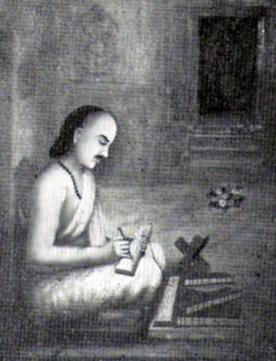
Narayanappa, known by his pen name Kumara Vyasa, was an influential and classical poet of early 15th century in the Kannada language. His pen name is a tribute to his magnum opus, a rendering of the Mahabharata in Kannada. Kumara Vyasa literally means "Little Vyasa" or "Son of Vyasa". He was the contemporary and archrival of the famous Veerashaiva poet laureate Chamarasa who wrote the seminal work Prabhulingaleele covering the lives of Allama Prabhu and other Shiva Sharanas, circa 1435. Both poets worked in the court of Deva Raya II.

Baba Budangiri, also known as Chandradrona, is a hill and mountain range in the Western Ghats of India, located in the Chikkamagaluru district of Karnataka.

Mahur or Mahurgad is a town and religious place in Nanded district of Maharashtra, India. Mahur is the birthplace of Hindu God Dattatreya. Dattatreya parents Atri Rishi and Sati Anasuya Mata lived here. Brahmadev, Vishnudev and Lord Shiva once got a news about Anusaya Mata that there is no one more pious and pure as her. To test her piousness they arrived under the garb of asking Alm (bhiksha). Near Mahur, There is a Pious confluence of River Penganga and River Pus at Hiwara Sangam village, Tal. Mahagaon Vidarbha, from where the river flows northward. Penganga river forms a border between Vidarbha and Marathwada. Mahur falls just about 3kms inside Marathwada due to river banks.

Kollur Mookambika Temple is located at Kollur in Byndoor Taluk of Udupi District in the state of Karnataka, India. It is a Hindu temple dedicated to the mother goddess Mookambika.
Uppinakudru, located 6 km north of Kundapura Udupi District, is a small island village, once famous for trading of salt (uppu) and seafood. UppinaKudru (UK) is also having short name of UK. So this is called as UK of Kundapura. This is also known as 'The King of Kudrus'.

Kumārasambhavam is an epic poem by Kālidāsa. It is widely regarded as the finest work of Kalidasa as well as the greatest kāvya poem in Classical Sanskrit. The style of description of spring set the standard for nature metaphors pervading many centuries of Indian literary tradition. Kumārasaṃbhavam basically talks about the birth of Kumāra (Kārtikeya), the son of Shiva (Śiva) and Pārvatī (Umā). The period of composition is uncertain, although Kalidasa is thought to have lived in the 5th century.

Sripada Sri Vallabha is an Indian guru of the Dattatreya sampradaya (lineage) who is an incarnation of Dattatreya. He is considered as one of the first complete avatars (incarnations) of the deity Dattatreya in Kali Yuga. Narasimha Saraswati, Manik Prabhu, Swami Samarth and Sai Baba of Shirdi are believed to be other incarnations of Dattatreya that followed Sripada Sri Vallabha.
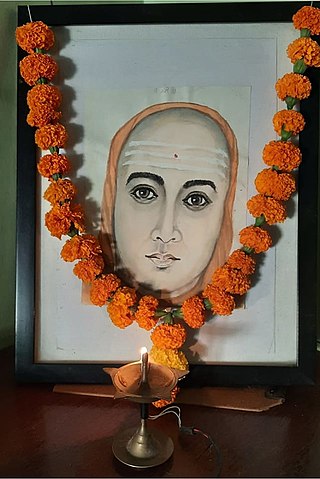
Shree Narasimha Saraswati Swami or Shree Nrusimha Saraswati Swami was an Indian guru of Dattatreya tradition(sampradaya). According to the Shri GuruCharitra, he is the second avatar of Dattatreya in Kali Yuga after Sripada Sri Vallabha.

Karnataka has a variety of traditional arts, including folk dance and puppetry.
Tarakasura is a powerful asura in Hindu mythology. He is the son of the asura Vajranga and his wife Vajrangi. Taraka had three sons: Tarakaksha, Vidyunmali, and Kamalaksha, who were known as the Tripurasura. He is slain by Kartikeya.
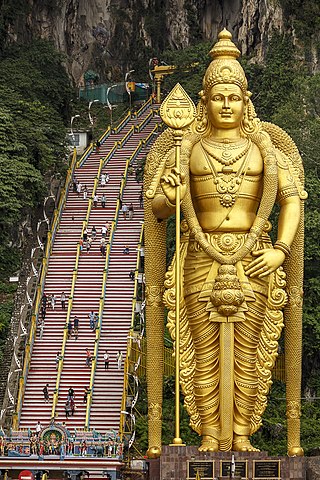
Kaumaram is a Hindu denomination that primarily venerates the Hindu deity of war, Kartikeya, also known as Kumaran, Murugan, Arumugan, and Subrahmanyan. Devotees of Kumaran, called Kaumaras, also revere members of his family: Parvati, Shiva, and Ganesha, as well his consorts, Devasena and Sundaravalli, the daughters of Vishnu in Tamil tradition. The important theological texts relating to Kumara are a part of the Shaiva agama canon. This sub-tradition is found among the Tamils, Kannadigas, and the Vedda, in South India, Sri Lanka, and among the Tamil diaspora worldwide. The love story of Kumara/Murugan and his wife Valli, a girl from a local tribe, is popular in Tamil Nadu, where Kumara acquired the status of a national god.
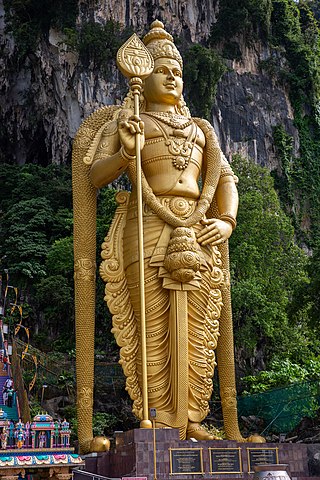
Kartikeya, also known as Skanda, Subrahmanya, Shanmukha and Murugan, is the Hindu god of war. He is generally described as the son of the deities Shiva and Parvati and the brother of Ganesha.
Kogga Devanna Kamath was an Indian artist who specialised in Yakshagana puppetry.
K. V. Ramesh is an Indian puppeteer, specialising in performances based on Yakshagana art. He most often performs in the Tulu Nadu region of Karnataka and Kerala. He leads the Yakshagana puppet troupe Shri Gopalakrishna Yakshagana Gombeyata Sangha, based out of Kasaragod.

Datta Jayanti, also known as Dattatreya Jayanti, is a Hindu festival, commemorating the birth of the Hindu deity Dattatreya (Datta), a combined form of the Hindu male divine trinity of Brahma, Vishnu, and Shiva.
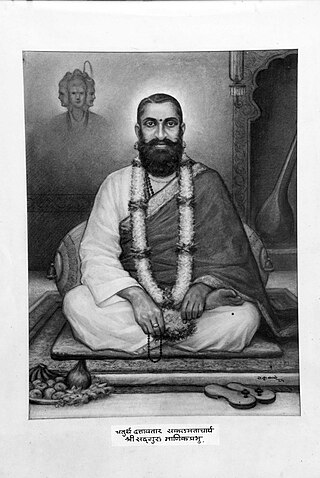
Manik Prabhu Maharaj was an Indian Hindu saint, freedom fighter, philosopher, poet and guru. He is also regarded as an incarnation of Dattatreya by the people of Datta Sampraday. Prabhu's philosophy, the Sakala mata Siddhanta rests on the principles of Advaita Vedanta as propagated by Adi Sankara. Shri Prabhu strongly advocated the essential oneness of all religions. Prabhu's Muslim devotees revered him as an incarnation of Mehboob Subhani whereas his Lingayat devotees saw him as a form of Basavanna. Shri Prabhu composed numerous bhajans and padas in various languages such as Marathi, Kannada, Hindi, Urdu and Sanskrit. Shri Prabhu was also associated with the First War of Indian Independence in 1857. Shri Sai Baba of Shirdi, Shri Swami Samarth of Akkalkot, Shri Bramhachaitanya of Gondavale and many other contemporary saints are believed to have visited Maniknagar to interact with Prabhu on matters of deep spiritual wisdom. Biographers refer to Shri Prabhu as a saint of great spirituality and mysticism. Shri Prabhu's teachings emphasize the path of Bhakti. He also moralized on the vedantic truths concerning the spiritual unity of beings. Manik Nagar, Humnabad, Bidar District is the place where he took sanjeevani samadhi. Shri Prabhu's samadhi at Maniknagar is the nucleus of Manik Nagar and acts as the spiritual center of the activities of Shri Manik Prabhu Samsthan.
Devi Adi Parashakti is a mythological television series based on the Hindu texts of the Shiva Purana, the Devi-Bhagavata Purana, the Markandeya Purana, and pan-Indian folktales of the Goddess. The series was created by Siddharth Kumar Tewary, directed by Loknath Pandey and Manish Singh, and produced by Swastik Productions. Rati Pandey plays the role of Devi Adi Parashakti and her incarnations Goddess Sati, and Goddess Parvati. Tarun Khanna played the role of Devi's husband, Lord Shiva with Kanan Malhotra as Lord Vishnu, Devi's brother. The show also features Sonia Singh as Goddess Diti, the main antagonist.
















